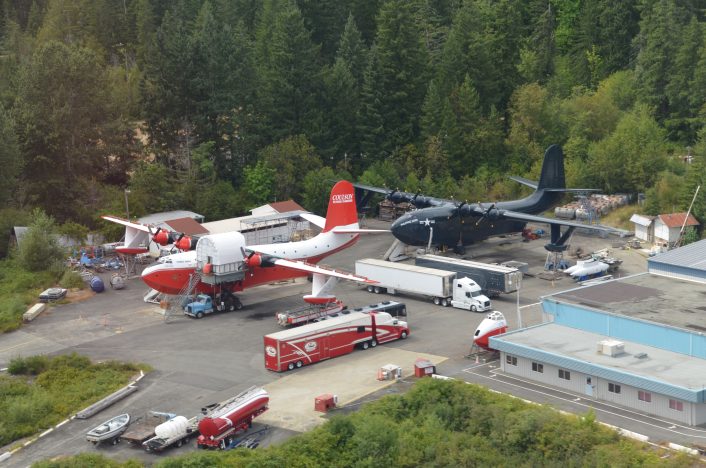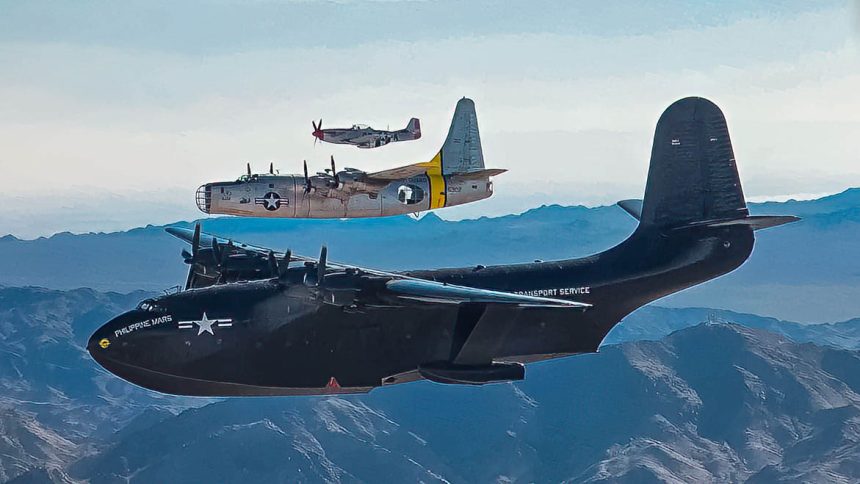The last Martin JRM Mars flying boat, Philippine Mars, retired after a career of almost 80 years, with its final flight taking the plane to Arizona for its final destination at the Pima Air and Space Museum.
After only a few months from the retirement of the other remaining Martin JRM Mars, Hawaii Mars II, the last surviving airframe of the large flying boat dating back to World War II, named Philippine Mars, was retired in February 2025. However, contrary to Hawaii Mars II, the iconic piece of British Columbia aviation history has left Canada and headed south towards the United States.
“It’s the end of the road. I hate to take it away from here, but they are going to good places,” said pilot Peter Killan, who was at the controls for the Philippine Mars’ retirement flight. “(We’re) sharing it for all of North America by having one in the states and one here.”
Historic final flight of the Martin Mars – 2/10/25. After being grounded for 17 years, Philippine Mars takes to the skies one last time for museum immortalization. Video by Luke Vold. pic.twitter.com/BmO8dW2KOV
— Pima Air & Space Museum (@pimaair) February 14, 2025
Philippine Mars
Philippine Mars, built as a JRM-1 Mars with BuNo 76820 and the third JRM Mars to be manufactured, was delivered on Jun. 26, 1946 to the U.S. Navy and based at Naval Air Station Alameda, California, until its retirement on Aug. 22, 1956, following the conversion to the JRM-3 standard during its service. Sold in 1959, like its other three surviving stablemates, “Marianas Mars”, “Hawaii Mars II” and “Caroline Mars”, it was converted to forest fire fighting aircraft by adding water tanks in the cargo bay with retractable pick-up scoops.
The aircraft flew with registration C-FLYK for FTI (Flying Tankers Inc.) until 2007, when, along with its surviving sibling “Hawaii Mars II”, it was sold to Coulson Group to be based at Sproat Lake in British Columbia, Canada. The other two Mars had in the meantime been lost, with “Marianas Mars” being destroyed in a crash with the loss of its crew near Nanaimo, Vancouver Island, on Jun. 23, 1961, while “Caroline Mars” was damaged beyond repair by Typhoon Freda at Victoria, Canada on Oct. 12, 1962

Whereas “Hawaii Mars II” (the particular naming being a result of the original namesake Hawaii Mars, the second JRM Mars built, sinking in the Chesapeake Bay just a few days after delivery on Aug. 5, 1945 and the name being recycled for the sixth Mars airframe) enjoyed an eventful career, dropping over 50 million gallons of water on fires during its 55 years of firefighting missions (which Coulson says is more than any other single firefighting aircraft in history anywhere in the world), “Philippine Mars” instead has not been employed on forest fires since the summer of 2007.
While “Hawaii Mars II” was upgraded with modern equipment, including an EFIS glass cockpit and multiple sensors to ensure accurate water drops, and painted in a bright high-visibility red livery typical of water bombers, “Philippine Mars” had been sitting at Sproat Lake since 2007 awaiting transfer to be put in permanent display at the Pima Air and Space Museum in Arizona, having received its original U.S. Navy dark blue livery and after originally being slated to transfer to the National Naval Aviation Museum at Naval Air Station Pensacola, Florida.
The Hawaii #MartinMars has made it to Greater Victoria! CHEK News video captured around 6:15 p.m. Sunday shows the moments the Hawaii water bomber flies over Patricia Bay in formation with the #Snowbirds. ✈️ @CHEK_News pic.twitter.com/Do1vQq8BJj
— Ethan Morneau (@EthanMorneau) August 12, 2024
“Hawaii Mars,” however, preceded “Philippine Mars” into retirement. Not having been used over fires since 2015 and with a lack of perspective buyers, “Hawaii Mars II” had its final flight in the summer of 2024, being retired to the British Columbia Aviation Museum of Sidney, on Vancouver Island, escorted on its final travel by nine CT-114 Tutors jet trainers of the Snowbirds, officially known as 431 Air Demonstration Squadron, the military aerobatics flight demonstration team of the Royal Canadian Air Force.
In early December 2024, “Philippine Mars” tried following the fate of its stablemate, but an issue with the number 2 engine (the left inboard one) forced it to return to Sproat Lake. A second attempt to fly to San Francisco on Dec. 15, 2024, had similarly to be aborted, after successfully overflying “Hawaii Mars II”, when an issue developed in the engine number 4 (the right outboard one), with “Philippine Mars” being forced to feather the propeller of the shut down engine and land in Patricia Bay, British Columbia, Canada.
The Philippine Mars has arrived in Arizona! ✈️ After an incredible journey from Sproat Lake, she’s now en route to her forever home at the Pima Air & Space Museum. A historic chapter closes, but her legacy lives on. #philippinemars #aviationhistory #coulsonaviation pic.twitter.com/oVJs1iQ2Xn
— Coulson Aviation (@CoulsonAviation) February 12, 2025
After replacing the number 4 engine with one taken from “Hawaii Mars II,” “Philippine Mars” was finally able to leave Sproat Lake on Feb. 9, 2025, later reaching San Francisco. “Philippine Mars” then departed the Californian city the next day for Lake Pleasant, Arizona, being escorted on the way by various historic airplanes, including the last remaining airworthy Consolidated PB4Y-2 Privateer (a derivate of the more famous B-24 Liberator), N2871G from Casa Grande, Arizona, and a P-51D Mustang (N44727).
From there, the “Philippine Mars” will be then disassembled for the final transport overland to the Pima Air and Space Museum in Arizona, where it will be sitting in company of its sibling Martin PBM Mariner and a collection of over 350 planes, including the last B-36 Peacemaker built, The City of Fort Worth, multiple B-52 Stratofortress in different variants, an SR-71 Blackbird, one of the two existing F-107 and the unique SOFIA (the Boeing 747-based Stratospheric Observatory for Infrared Astronomy) from NASA.
Good morning from Lake Pleasant AZ and the Philippine Mars. #philippinemars #martinmars #cflyk #flynavy #pimaairandspacemuseum #aviationsafari #aviationpreservation #boneyardsafari #aviationadventures pic.twitter.com/7W7advU2NH
— Boneyard Safari (@Boneyardsafari) February 18, 2025
The Martin JRM Mars
Designed and built by the Martin Company, the precursor company that was later to merge first with American-Marietta, to form Martin-Marietta, and later with Lockheed to create the modern Lockheed Martin corporation, the JRM Mars flying boat was created in 1938 in response to a United States Navy request for a long-range ocean patrol flying boat. To create the Martin Mars, the Martin Company scaled up its own PBM Mariner patrol bomber flying boat, an already large airplane designed to complement the smaller Consolidated PBY Catalina and the slightly larger Consolidated PB2Y Coronado in American service.
By scaling up the successful Mariner (of which 1,366 were made, with the last one retiring only in 1964 after being replaced by another Martin flying boat, the Martin P5M Marlin) and adding two engines to the plane, the Martin Company was thus able to produce the very large JRM Mars, creating what would be the largest Allied flying boat of World War II.
The large four-engine flying boat, however, encountered development issues that delayed its introduction, with the design, started in late 1941, becoming by 1943 increasingly obsolete for its intended role of patrol bomber, instead spurring the conversion of the Mars into a large cargo transport aircraft. As the first airplane was delivered only in June 1945, the original order for 20 flying boats was scaled back with the end of the World War, reducing the production to just 7 airframes.
The legendary Philippine Mars is on her way to Arizona, and thanks to our partnership with SKYTRAC, you can track her journey in real time! #coulsonaviation #philippinemartinmars
📍 Track her progress here: https://t.co/Giv1mJwYdm pic.twitter.com/x65yHOpZeY
— Coulson Aviation (@CoulsonAviation) February 9, 2025
Declining use of flying boats
The retirement of the last of the aging Mars giants comes after news of the retirement of the first ShinMaywa US-2 seaplane, and further shrinks the number of large flying boats operational worldwide. While the US-2 and the Chinese AG600 are still in production, they are available only in very limited numbers and so far failed to receive foreign orders.
A floatplane development of the Lockheed C-130 cargo plane, that has long been discussed, has apparently also been shelved recently. Flying boats could be useful for operations in the Pacific Ocean, from special forces raids to missions in areas lacking proper infrastructure or only having austere locations, but the additional cost, impact on performance and more limited cargo and weapons capacity have so far limited flying boats operation to very niche use in little numbers.
Even the role of water bombers, where amphibious airplanes like the famous Canadair CL-215 and CL-415 firefighting aircraft have the advantage of being able to refill their tanks from bodies of water close to the fire they’re fighting, is increasingly filled by land-based aircraft, either dedicated conversions of airliners like McDonnell-Douglas DC-10s or Boeing 737s and 747s, or military cargo planes with specialized kits, with MAFFS kits first developed in the 1970s to equip the U.S. Air Force’s fleet of C-130s, and Leonardo recently adapting its C-27J Spartan NG to the firefighting role with the addition of the MAFFS II system.








